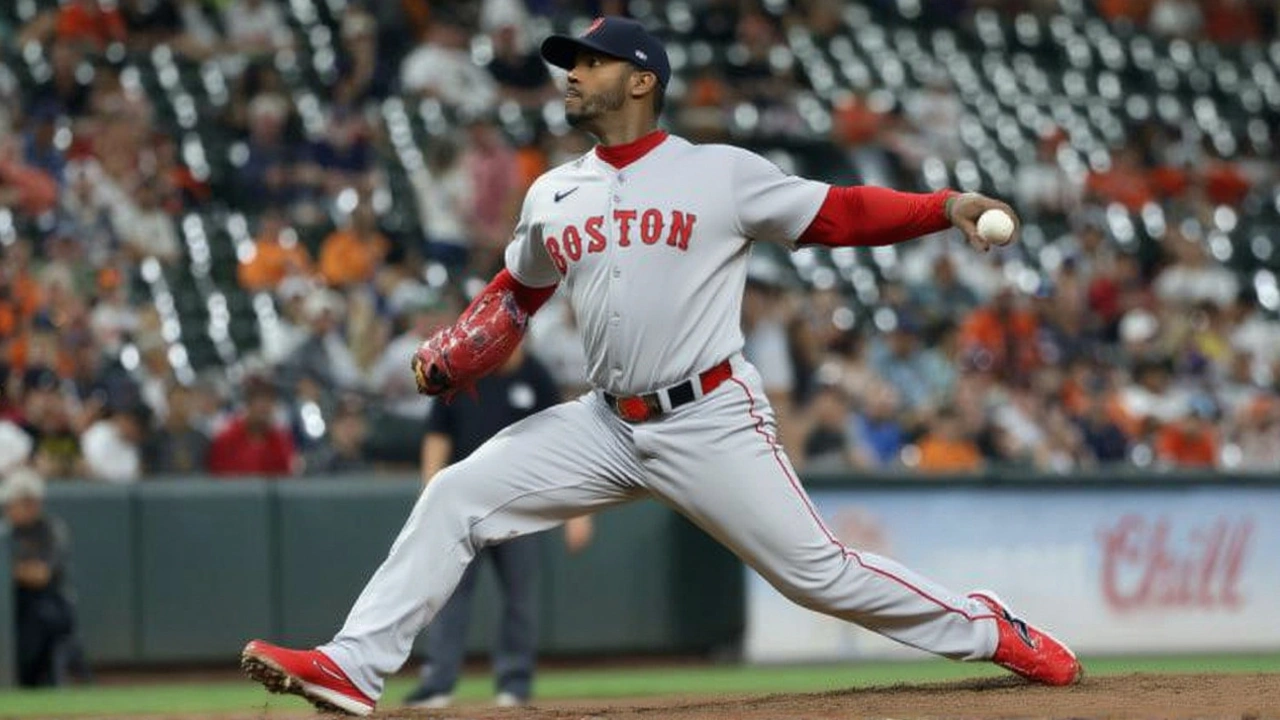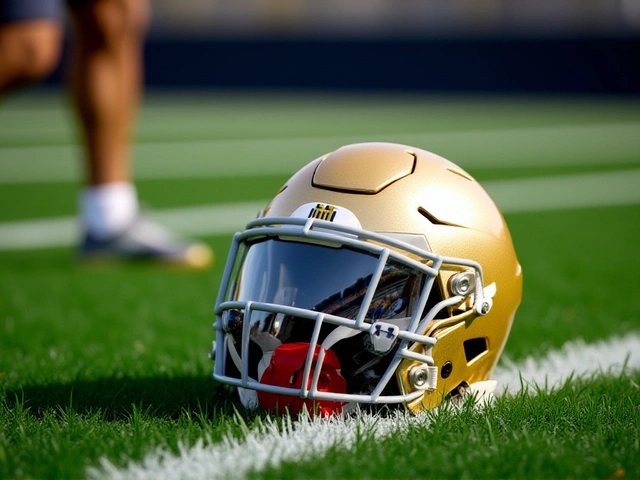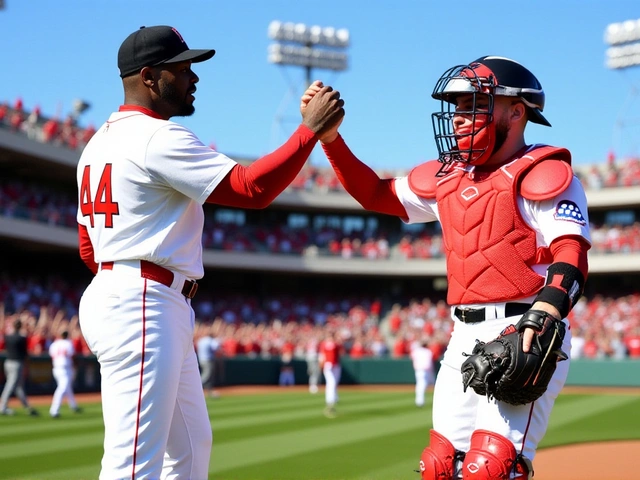Aroldis Chapman's Late‑Career Surge Fueled by PitchCom Breakthrough

When Aroldis Chapman, the veteran closer for Boston Red Sox, turned in a career‑low 1.04 ERA at age 37, the baseball world took notice.
The 2025 season has turned into a redemption story for the Cuban‑born left‑hander, who now sits seventh in Major League Baseball (MLB) with 26 saves and boasts an unbeaten 0.00 ERA for the month of August. The secret? A simple adjustment sparked by catcher Connor Wong during spring training, and the high‑tech PitchCom system that called the play.
How a Spring‑Training Demo Redefined a Legend
Inside the dugout of the Red Sox spring camp, Buster Olney, veteran MLB insider for ESPN, recounted the defining moment on his latest podcast. "Connor was using PitchCom and pushed the ‘inside fastball’ button," Olney said. "Suddenly a light‑bulb went off for Chapman – he’d never even thought about spotting his fastball. He’d just been hurling straight at the plate for years."
PitchCom, a wireless communication device that lets catchers relay pitch selections without shouting, gave Wong the ability to focus on location rather than just velocity. When he asked Chapman to aim an inside fastball, the closer finally realized he could “spot” his 100‑plus‑mph shots, a skill he’d been missing in his earlier years.
Even the Red Sox’s game‑planning and run‑prevention coach, former catcher Jason Varitek, weighed in. "It’s like giving a sniper a sight," Varitek joked. "Chapman’s stuff was always there; we just needed the right aim."
Statistical Turnaround: Numbers That Speak
Chapman’s revamped approach translates into eye‑popping stats. Over his first 54 innings of the 2025 campaign, he posted a 1.78 Fielding Independent Pitching (FIP) metric, 77 strikeouts and a mere 14 walks – a walk rate of 7.1%, the lowest of his 15‑year career. By contrast, from 2021‑2024 he walked roughly 15% of batters faced, a clear sign of deteriorating control.
- 26 saves (7th in MLB)
- 1.04 ERA (career‑best for 40+ appearances)
- .130 opponent batting average
- 0.00 ERA in August (11 appearances, 12 K, 0 H)
- 9 consecutive hit‑free outings – a personal first
He also ranks third all‑time in OPS allowed, a metric that combines on‑base and slugging percentages against a pitcher, underscoring how few quality hits have slipped past him.
From Skepticism to a Contract Extension
The Red Sox took a gamble in December 2024, signing Chapman to a one‑year, $10.75 million deal. Critics argued his fastball velocity had already dipped and that his erratic command made him a liability. Yet the numbers have silenced doubters, prompting Boston to lock him up through 2026 with a $13.3 million extension that includes a $12 million salary for 2026, a $1 million signing bonus, and a $300,000 buyout if the 2027 mutual option isn’t exercised. That option becomes guaranteed if Chapman throws 40 innings in 2026 and passes a post‑season physical.
"We believed in Aroldis’s work ethic and his desire to adapt," Red Sox GM Chaim Bloom said in a recent press conference. "The PitchCom revelation proved that even a veteran can evolve. It’s a win‑win for the club and the player."

Impact on Boston’s Playoff Push
Boston now sits firmly in the wild‑card race, with Chapman providing a dependable anchor in the ninth inning. His dominance has allowed the Red Sox to lean less on other relievers, stabilizing a bullpen that was previously labeled "the most volatile in the AL." In the upcoming wild‑card showdown against the New York Yankees, Chapman's experience – he’s pitched in three World Series – could be the X‑factor.
Moreover, his resurgence has sparked interest from other teams eyeing free agency. Should he maintain this trajectory, Chapman could command a multi‑year, multi‑million deal next offseason, reshaping the market for elite closers.
Why This Matters Beyond Boston
Chapman’s story illustrates how technology, in the form of PitchCom, can extend the careers of even the most physically gifted athletes. It also challenges the conventional wisdom that elite velocity can’t be paired with precise location after the age‑30 mark. For younger pitchers, the lesson is clear: mastering the art of “spotting” is as vital as raw speed.
In the grander scheme, MLB clubs may revisit their own catcher‑pitcher communication tools, looking for hidden performance gains. If the Red Sox’s experiment pays off long term, PitchCom could become a standard fixture in bullpen rooms across the league.
What’s Next for Chapman and the Red Sox?
The next few weeks will be telling. Chapman aims to finish the regular season with at least 30 saves, a milestone that would cement his revival. Boston, meanwhile, will monitor his innings closely; the 2027 mutual option hinges on him reaching the 40‑inning threshold in 2026.
Fans can expect Chapman to keep using the inside fastball as his go‑to pitch, especially in high‑leverage situations. As for the Red Sox, their front office is reportedly scouting additional veteran arms to complement Chapman’s newfound consistency, ensuring the bullpen remains a playoff‑ready unit through the fall.

Frequently Asked Questions
How does Chapman’s improved control affect the Red Sox bullpen?
By lowering his walk rate to 7.1% and eliminating hits in critical August outings, Chapman has allowed Boston to rely less on middle‑relief arms. This stability reduces the overall workload on the bullpen, preserving arms for late‑season stretch runs and playoff games.
What role did PitchCom play in Chapman’s turnaround?
PitchCom let catcher Connor Wong signal an ‘inside fastball’ without shouting. The explicit call forced Chapman to think about pitch location for the first time in his career, leading to the realization that he could spot his fastball and dramatically improve his command.
Is Chapman’s success likely to continue into next season?
If he remains healthy and keeps the spotting technique, the metrics suggest he can sustain a sub‑2.00 ERA. The Red Sox contract extension includes a conditional 2027 option tied to innings pitched, indicating the club’s confidence in his continued effectiveness.
Will other MLB teams adopt PitchCom after seeing Chapman’s results?
Experts predict a ripple effect; teams are already evaluating how wireless pitch‑calling can improve pitcher‑catcher synergy. Chapman’s case provides a high‑profile example that technology can unlock hidden performance even for seasoned veterans.
How significant is Chapman’s wild‑card impact against the Yankees?
Facing a familiar foe, Chapman’s experience in high‑pressure situations could be decisive. With a 0.00 ERA in August and a proven ability to close games, his performance may tip the balance in a series that could decide the AL East crown.





